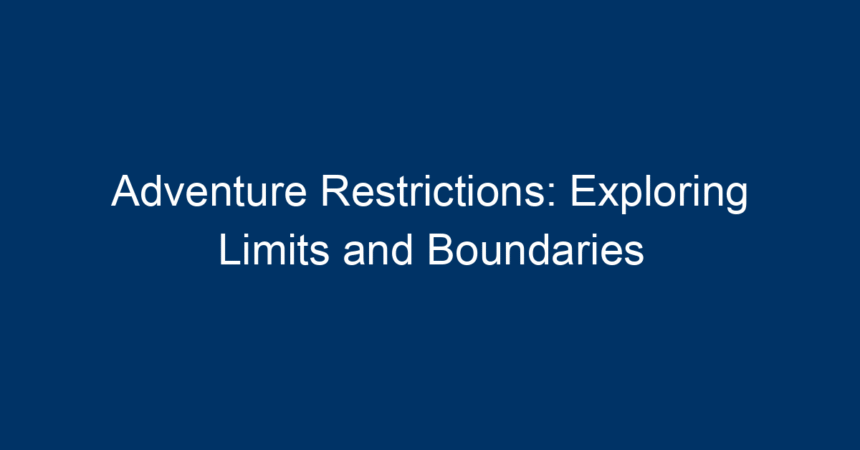Adventure is synonymous with excitement, exploration, and pushing the limits of the human experience. However, within every ambitious quest lies a set of adventure restrictions that shape the journey. Whether dictated by nature, regulations, or personal boundaries, understanding these limitations is vital for safe and successful excursions. This article delves into adventure restrictions, examining their importance, types, and how to navigate them effectively.
Understanding Adventure Restrictions
At their core, adventure restrictions serve a purpose—ensuring safety, protecting the environment, and maintaining order in adventurous pursuits. These limits can stem from various sources, including legal regulations, environmental concerns, or personal capabilities. It’s crucial for adventurers to recognize and respect these boundaries to foster a culture of responsible exploration.
Types of Adventure Restrictions
1. Legal Restrictions
Many outdoor activities are governed by laws and regulations set forth by local, state, or federal authorities. These may include:
- Permits and Licensing: Depending on the activity—hiking, rock climbing, or kayaking—certain permits might be required. For example, national parks often require permits for backcountry camping to manage visitor impact.
- Age Limits: Safari tours, white-water rafting, or diving courses may impose age restrictions to ensure participants are physically and mentally prepared for the experience.
- Restricted Areas: Some locations are off-limits to protect wildlife or preserve cultural heritage. Violating these restrictions can result in hefty fines.
2. Environmental Restrictions
Environmental factors play a critical role in shaping adventure restrictions. Here are some key considerations:
- Weather Conditions: Activities like mountain climbing or sailing can be severely impacted by inclement weather. For instance, high winds or storms can make climbing routes unsafe.
- Seasonal Closures: Many trails or parks have seasonal restrictions, closing during breeding seasons for wildlife or periods of high fire risk.
- Sustainability Practices: Responsible adventurers are encouraged to follow Leave No Trace principles, which may limit certain actions, such as campfires or off-trail hiking, to minimize environmental impact.
3. Personal Limitations
Beyond the external restrictions imposed by laws and nature, personal boundaries must also be acknowledged. These include:
- Physical Fitness: Understanding one’s physical capabilities is crucial. Attempting an adventurous activity without adequate fitness can lead to injuries or adverse outcomes.
- Skill Level: Joining an activity above one’s skill level can be dangerous. Adventurers should assess their abilities honestly before exploring a new endeavor.
The Importance of Respecting Adventure Restrictions
Respecting adventure restrictions is not just a legal obligation; it’s a moral responsibility towards oneself and the larger community. Here are some reasons why these limitations matter:
Safety First
Adventure restrictions are designed primarily for safety. They help protect individuals from hazards and ensure that everyone can enjoy the experience without undue risk. By adhering to restrictions, adventurers reduce the likelihood of accidents and injuries.
Environmental Protection
The natural world is fragile. Adventure restrictions help preserve ecosystems and minimize human impact. For example, restricted access to certain trails during breeding seasons allows wildlife populations to thrive. Protecting these areas ensures they remain beautiful and accessible for future generations.
Enhancing the Adventure Experience
Interestingly, exploring within restrictions can enhance the overall experience. By learning to work within constraints, adventurers may find unique routes or activities that they wouldn’t have considered otherwise. For instance, some hidden gems can often be discovered in areas deemed "off-limits" to typical tourists, providing an exclusive experience.
How to Navigate Adventure Restrictions
1. Research Before You Go
Before embarking on any adventure, thorough research is essential. This includes:
- Reviewing Local Regulations: Check websites of parks, zoning authorities, or recreational bodies relevant to your destination. Understanding the rules that apply to your intended adventure will prevent legal issues and enhance safety.
- Assessing Environmental Conditions: Look up recent weather forecasts, trail reports, and potential hazards such as wildlife encounters or environmental alerts. Apps and websites specifically for outdoor adventurers can provide real-time information.
2. Pre-Trip Planning
Planning an adventure involves organization and foresight. Here are some steps to consider:
- Acquire Necessary Permits: If your trip requires permits, secure them well in advance. Some permits are issued on a first-come, first-served basis, especially during peak seasons.
- Plan for Safety: Ensure you have the right gear, enough food and water, and a first aid kit. Knowing the local emergency contacts can also be invaluable—don’t hesitate to save those numbers on your phone.
3. Communicate and Educate
Talking to fellow adventurers, park rangers, or local guides can provide insights that may not be available online. Engaging with others not only enhances your understanding of adventure restrictions but can also enrich your experience.
4. Adapt and Embrace Flexibility
Adventure is about spontaneity and discovery, so embrace flexibility in your plans. If a particular trail or park is closed, consider alternative activities. The ability to adapt ensures that your spirit of adventure remains high.
Conclusion: The Path to Responsible Adventure
Navigating adventure restrictions isn’t just about compliance; it’s a profound part of being a responsible adventurer. By recognizing and understanding these limits—be they legal, environmental, or personal—we open ourselves to safer and more rewarding experiences.
In your quest for adventure, remember: enforcing boundaries does not curtail exploration but rather enriches it. Stay informed, plan wisely, and always prioritize safety and sustainability. In doing so, you contribute to preserving the breathtaking landscapes we all cherish, ensuring they endure for adventurers who come after you.
Actionable Insights
- Start small: If you’re new to outdoor adventures, look for beginner-friendly activities that respect adventure restrictions.
- Form a community: Join local adventurer clubs to share knowledge about restrictions and responsible practices.
- Educate others: As you learn, pass on the knowledge to fellow adventurers to promote a culture of safety and respect.
Being proactive about understanding adventure restrictions leads not only to personal growth but also positively impacts our shared environment—allowing everyone the chance to explore the world responsibly.




